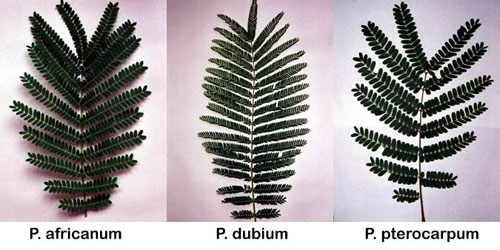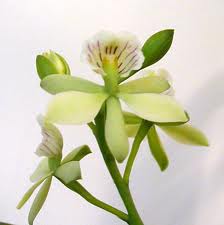Philodendron
As Houseplants or Greenhouse plants:These make great houseplants. They thrive in temperatures between 60 and 72 degrees and they require less light than most plants. It is best to grow them in pots of soil, but some, such as, P. oxycardium, will live for a long time in water to which a few pieces of charcoal have been added. The leaves should be cleaned with soapy water or an insecticide once in a while to remove dust and to control insects. Plants that have a good supply of roots will benefit from applications of a dilute liquid fertilizer every week or two. During the summer, they may be buried up to their rims in sand or ashes in a shady place outside or on a porch. When these plants are grown in a greenhouse, they prosper in a humid, tropical atmosphere. The minimum night temperature should be 60 degrees and the minimum day temperature should be 5-10 degrees higher. A damp atmosphere can be maintained by frequently wetting the floor and benches in the greenhouse and by spraying the foliage several times a day in the summer. During the winter months, less humidity is required, but the air must not become too dry. From mid-February to mid-November they need to be shaded from direct sun. Whether they're grown in a home or greenhouse, they need well-drained pots that aren't too large for the plants. They do best when their roots are slightly cramped, but not too tightly packed that they form a tight ball of roots.
Propagation
Pieces of stem that contain at least two joints can be inserted as cuttings in pots of sandy peat or in a mixture of sand and peat moss in a greenhouse propagating bench in the spring or summer. The pots should be placed in a propagating case with a bottom heat of 70-75 degrees or they can be kept under a bell jar or in a terrarium in a warm room. They need to be shaded from direct sun during their rooting period. When roots have formed, they can be potted in 3-inch pots and next, in 5-inch pots. When they have filled these pots up with roots they can be planted in larger pots or in beds of soil. Another way to root cuttings (especially the cuttings of the trailing kinds) is to place their lower parts in a container filled with water and a few pieces of charcoal and keep them in 65- to 72-degree temperatures. They should root within 4-8 weeks. Philodendrons can easily be increased by air layering. Philodendron seeds will quickly sprout if they're sown in sphagnum moss or in a mixture of peat moss and sand or in some similar rooting medium as soon as they are ripe. They should not be allowed to dry after they are removed from the fleshy covering that surrounds them. They'll germinate readily if they are kept moist in a 75- to 80-degree temperature. When they're large enough to handle easily, they should be potted in small pots filled with coarse, porous soil.
P. dubium

P. radiatum
VARIETIES
- P. Andreanum (Climber; L. green suffused with brown, ivory veins);
- P. bipinnatifidum (Grows slowly; L. dark green, 2 ft., two lobes, prominent veins);
- P. calophyllum (L. pointed, heart-shaped, bright, glossy green);
- P. cannifolium (Non-climber; L. paddle-shaped with wavy edges);
- P. cordatum (Climber; L. sm. to med. sized, arrow-shaped, copper underneath);
- P. dubium (L. deeply lobed, dark green);
- P. erubescens (Climber; L. med. sized, arrow-shaped, copper underneath);
- P. giganteum (Grows erect; L. large, ovate-heart-shaped, glossy, dark green, lighter veins);
- P. gloriosum (Climber; L. large, heart-shaped, dark green with reddish edges and ivory veins);
- P. hastatum (Climber; L. bright green; arrow-shaped);
- P. Imbe (Climber; L. pointed, lance-shaped, green on top and red beneath);
- P. lacerum (Climber; L. large, heart-shaped, light green, deeply lobed margins);
- P. laciniatum (Climber; L. deeply lobed or fingered, light green);
- P. Mamei (L. large, heart-shaped, green variegated with white);
- P. micans (Climber; L. sm., heart-shaped, green above and red beneath);
- P. nobile (L. broad, lance-shaped);
- P. oxycardium (Climber; slender stems and L. sm., broad, heart-shaped, dark green);
- P. panduraeforme (Climber; L. sm., broad, heart-shaped, dull, dark green. They are somewhat shaped like a horse's head thus the name Horsehead Philodendron. Great house plant.);
- P. pertusum;
- P. radiatum (Climber; L. deeply lobed, rich green);
- P. sagittifolium (Vigorous climber; L. arrow-shaped, glossy, light green);
- P. Selloum (L. long-stalked, large, deeply lobed, dark green);
- P. Sodiroi (Climber; L. heart-shaped, leaden-silver colored);
- P. squamiferum (L. five-lobed, shiny, rich green. Leaf stalks have thick, furry covering of long, red hairs);
- P. tripartitum (Climber; L. narrow, three-lobed, green);
- P. verrucosum (Climber; L. heart-shaped, satiny green shaded with iridescent olive hue. Leaf stalks covered with noticeable red hairs);
- P. Wendlandii (L. short-stemmed, paddle-shaped, green. They spread upwards and outwards from a common center). The following are some of the more outstanding kinds of hybrid Philodendrons developed mostly by American breeders: P. Alleni (L. glossy green, lobed);
- P. Barryi (L. glossy, deeply lobed);
- P. borinquensis (L. large, heart-shaped, shallowly lobed, green with reddish veins underneath);
- P. Evansii (L. huge, shiny, lobed and undulate);
- P. Florida compactum (Climber; L. lobed and petioles (leaf stems) have a reddish color);
- P. Lynette (L. bright green with depressed veins);
- P. Mandaianum (Vigorous climber; L. arrow-shaped, bronzy or reddish colored, red leafstalks);
- P. McNeilianum (L. triangular, deeply lobed, wavy margins);
- P. Orlando (L. broad, paddle-shaped);
- P. rubescens (Climber; L. arrow-shaped, bronze-green, red veins underneath);
- P. rubrum (Climber; L. pointed, heart-shaped and coppery or whitish veins. Leaf stalks are red.);
- P. tricolor (L. forms large rosette of long, arrow-shaped, green. Irregularly splashed with cream and white markings);
- P. wendatum (Slow climber; L. long, thick, oblong, dark green and reddish underneath);
- P. wend-imbe (L. Broader and more oval than P. wendatum. Undersides are pink.);
- P. Wilsonii (Slow climber; L. large, glossy, bright green, coarsely toothed, heart-shaped).




